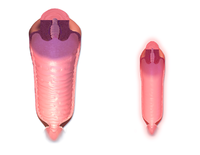
Photo from wikipedia
Study Objective Emergency department (ED) testing for sexually transmitted infections (STI) in women is typically performed with a pelvic examination and an endocervical swab. However, vaginal swabs are effective for… Click to show full abstract
Study Objective Emergency department (ED) testing for sexually transmitted infections (STI) in women is typically performed with a pelvic examination and an endocervical swab. However, vaginal swabs are effective for STI testing and the preferred specimen type according to the US Centers for Disease Control and Prevention. The utility of using vaginal swabs in the ED for STI screening has not been thoroughly investigated. Our objective was to assess detection rates for two bacterial STIs before and after implementing a screening protocol using vaginal swabs. Methods We conducted a quasi-experimental, pre-post study using standardized data from electronic health records across nine metropolitan Detroit hospital EDs. Patients included women who were tested for Chlamydia trachomatis or Neisseria gonorrhoeae in the ED between April 2018–December 2019. Pre-implementation tests from April 2018–February 2019 were done using endo-cervical swabs, and post-implementation tests from February 2019–December 2019 were done with vaginal swabs. We used non-inferiority testing for proportion with a non-inferiority margin of one percentage point absolute difference in detection rates of STI. Results The study included 22,291 encounters with 11,732 in the pre-implementation and 10,559 in the post-implementation phases. The C. trachomatis detection rates were 7.5% pre-implementation and 7.6% post-implementation (between-group difference, 0.1 percentage points; 95% confidence interval [CI]: −0.7, 0.4; p<.01 for non-inferiority). The N. gonorrhoeae detection rates were 3.1% pre-implementation and 3.6% post-implementation (between-group difference, 0.5 percentage points; 95% CI: −0.8, 0.04; p<.01 for non-inferiority). Conclusion Using vaginal swabs for STI testing in the ED may be a non-inferior alternative to using endocervical swabs.
Journal Title: Western Journal of Emergency Medicine
Year Published: 2022
Link to full text (if available)
Share on Social Media: Sign Up to like & get
recommendations!